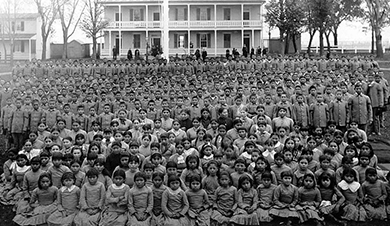Americanization
Through the years of the Indian Wars of the 1870s and early 1880s, opinion back east was mixed. There were many who felt, as General Philip Sheridan (appointed in 1867 to pacify the Plains Indians) allegedly said, that “the only good Indian was a dead Indian.” But increasingly, several American reformers who would later form the backbone of the Progressive Era had begun to criticize the violence, arguing that the government should help the Native Americans through an Americanization policy aimed at assimilating them into American society. Individual land ownership, Christian worship, and education for children became the cornerstones of this new assault on Native life and culture.
Beginning in the 1880s, clergymen, government officials, and social workers all worked to assimilate Native peoples into American life. The government helped reformers remove Native American children from their homes and the cultural influence of their families and place them in boarding schools, such as the Carlisle Indian School, where they were forced to abandon their tribal traditions and embrace Euro-American social and cultural practices. Such schools acculturated Native American boys and girls and provided vocational training for males and domestic science classes for females. Boarding schools sought to convince Native children to abandon their language, clothing, and social customs for a more Euro-American lifestyle (Figure 17.14).

A vital part of the assimilation effort was land reform. During earlier negotiations, the government had recognized Native American communal ownership of land. Although many tribes recognized individual families’ use rights to specific plots of land, the tribe owned the land. As a part of their plan to Americanize the tribes, reformers sought legislation to replace this concept with the popular Euro-American notion of real estate ownership and self-reliance. One such law was the Dawes Severalty Act of 1887, named after a reformer and senator from Massachusetts. In what was essentially a new version of the original Homestead Act, the Dawes Act permitted the federal government to divide the lands of any tribe and grant 160 acres of farmland or 320 acres of grazing land to each head of family, with lesser amounts to single persons and others. In a nod towards the paternal relationship with which White people viewed Native Americans—similar to the justification of the previous treatment of enslaved African Americans—the Dawes Act permitted the federal government to hold an individual Native American’s newly acquired land in trust for twenty-five years. Only then would they obtain full title and be granted the citizenship rights that land ownership entailed. It would not be until 1924 that formal citizenship was granted to all Native Americans. Under the Dawes Act, Native Americans were assigned the most arid, useless land and “surplus” land went to White settlers. The government sold as much as eighty million acres of Native American land to White American settlers.

